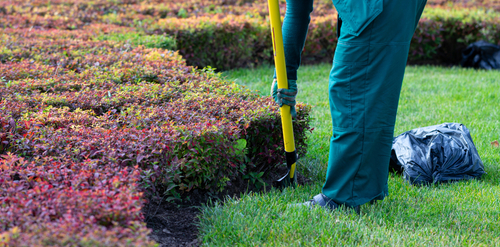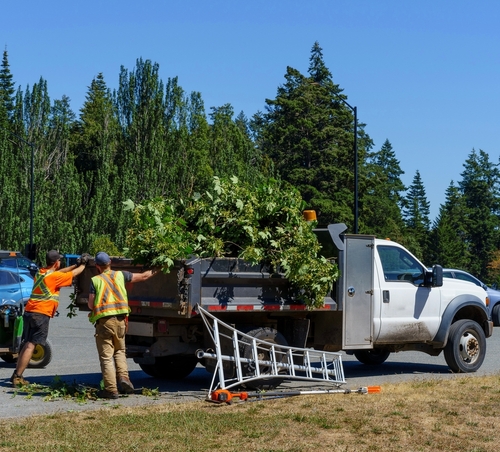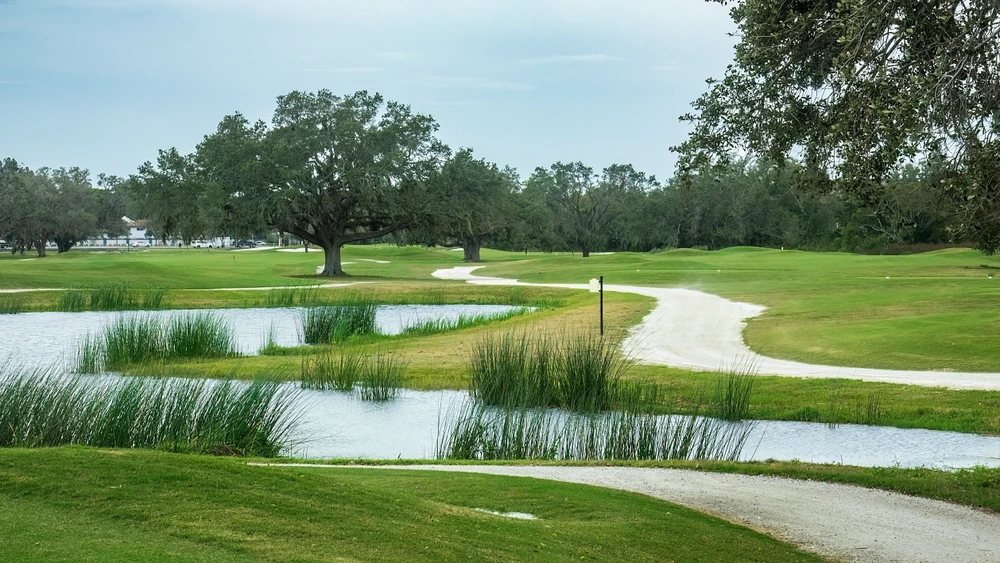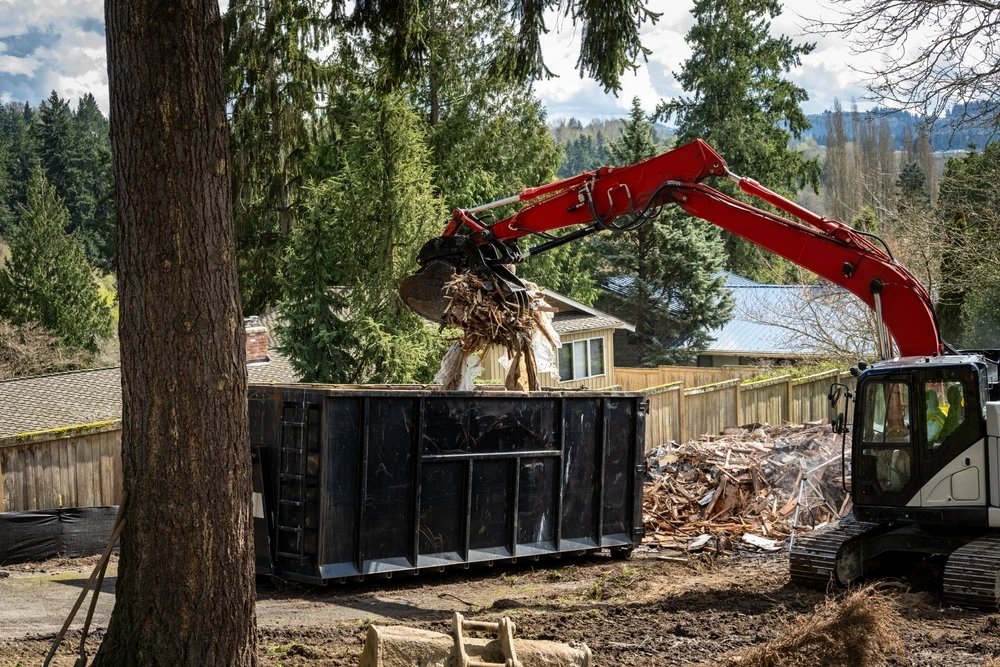Maintaining a beautiful and neat landscape can be a daunting task, particularly after months of neglect. A well-executed landscape cleanup can transform your yard, boost curb appeal, and create a welcoming outdoor environment. From pruning overgrown shrubs to removing fallen leaves and debris, the process demands careful planning and the right tools.
Assessing the needs of your landscape is the first critical step. Observe your yard and note the areas that require attention, whether it’s overgrown grass, fallen branches, or old mulch. Utilizing a yard waste dumpster rental can streamline the cleanup process, especially for large projects.
Whether you choose to do it yourself or hire professional services, having a well-thought-out strategy will save you time and effort. In the following sections, we will explore essential tips and tools you need for a successful landscape cleanup.
 Selecting the right tools and using them properly is key to efficient and safe landscape cleanup. This guide will break down the best choices and safety measures for your yard work.
Selecting the right tools and using them properly is key to efficient and safe landscape cleanup. This guide will break down the best choices and safety measures for your yard work.
 Properly maintaining your lawn involves regular mowing and edging, aerating and fertilizing the soil, and controlling weeds and pests.
Properly maintaining your lawn involves regular mowing and edging, aerating and fertilizing the soil, and controlling weeds and pests.
 Proper mulching and soil care are crucial for maintaining healthy flower beds and creating a thriving landscape. Mulch helps conserve moisture, regulate soil temperature, and prevent weed growth, while good soil preparation ensures strong root development.
Proper mulching and soil care are crucial for maintaining healthy flower beds and creating a thriving landscape. Mulch helps conserve moisture, regulate soil temperature, and prevent weed growth, while good soil preparation ensures strong root development.
 To keep your property looking its best, consistent efforts in landscape cleanup and maintenance are crucial. This not only enhances the visual appeal but can also significantly boost your property value.
To keep your property looking its best, consistent efforts in landscape cleanup and maintenance are crucial. This not only enhances the visual appeal but can also significantly boost your property value.
 Beginner’s Guide to Dumpster Rentals: Essential Tips for Effective Waste Disposal
Beginner’s Guide to Dumpster Rentals: Essential Tips for Effective Waste Disposal
Date: September 18 ,2024
 Comprehensive Move-Out Cleaning Checklist: Essential Steps for a Spotless Exit
Comprehensive Move-Out Cleaning Checklist: Essential Steps for a Spotless Exit
Date: September 16 ,2024
Key Takeaways
- Identify and assess areas that need cleanup in your landscape
- Use a yard waste dumpster rental to efficiently manage large cleanup tasks
- Plan your strategy and gather the necessary tools for effective landscape maintenance
Assessing Landscape Cleanup Needs
Begin your landscape cleanup by thoroughly evaluating your outdoor space. Proper assessment ensures you identify all necessary tasks and create a comprehensive plan for a successful cleanup.Identifying Overgrown Areas
Start by walking around your yard and noting any overgrown or neglected areas. Look for shrubs and trees that need pruning to maintain their shape and health. Overgrown plants can block sunlight, preventing grass and smaller plants from thriving. Inspect your lawn for excessive weed growth and areas where grass may have thinned. Weeds compete with your plants for water and nutrients, so addressing them is crucial. Additionally, look for plants or shrubs that may be crowding each other. Proper spacing is essential for air circulation and growth. By identifying these overgrown areas, you can prioritize your tasks and ensure your landscape remains healthy and attractive. Consider creating a list or map to visualize the problem areas and address them systematically. Regular attention to these areas will keep your yard looking pristine and well-maintained.Planning Your Cleanup Strategy
Effective landscape cleanup begins with thorough planning and organization. By creating a detailed checklist and determining the appropriate cleanup frequency, you can ensure that your yard remains beautiful and healthy throughout the year.Creating a Checklist
Start by listing all the tasks you need to accomplish. Include activities like raking leaves, pruning shrubs, and removing debris. Break these down by specific areas of your yard, such as gardens, walkways, and lawns. Use a seasonal approach to address different needs. For example, focus on leaf removal in the fall and pruning in early spring. Make sure to include essential tools like rakes, pruning shears, and garbage bags. Check off completed tasks to keep track of your progress. This approach helps you stay organized and ensures nothing is overlooked. A thorough checklist can make your landscape cleanup more efficient and manageable.Determining Cleanup Frequency
Decide how often you need to clean your landscape based on factors like climate, vegetation type, and yard size. For instance, areas with heavy leaf fall may require weekly attention during autumn. In contrast, minimal cleanup might be needed during summer months when growth slows. Regular maintenance can prevent larger issues. Schedule monthly inspections to identify potential problems early. This proactive approach can save time and effort in the long run. Adjust frequency based on your observations. If debris accumulates quickly, consider more frequent cleanups. Conversely, if your yard stays relatively tidy, longer intervals may suffice. Customizing your cleanup schedule ensures that your landscape remains pristine throughout the year.Tools and Equipment
 Selecting the right tools and using them properly is key to efficient and safe landscape cleanup. This guide will break down the best choices and safety measures for your yard work.
Selecting the right tools and using them properly is key to efficient and safe landscape cleanup. This guide will break down the best choices and safety measures for your yard work.
Choosing the Right Tools
Proper landscaping requires an array of tools. For cutting tasks, shears and a trimmer are essential. Shears are perfect for precise pruning, while a trimmer can handle larger hedges. For clearing leaves and debris, a rake is indispensable. Consider multitasking tools like the 3-in-1 blower, mulcher, and vacuum. It combines three functions in one, making it versatile for leaf cleanup. You might also need a spreaders for tasks like fertilizing or seed distribution. For larger cleanup projects, renting a yard waste dumpster can be practical. It provides a convenient way to dispose of debris without multiple trips to a landfill.Proper Use and Safety
Using tools correctly ensures both efficiency and safety. When operating shears or a trimmer, always wear gloves to protect your hands from cuts. It’s crucial to maintain the tools’ sharpness for clean cuts and less strain. When using a rake, stand in an ergonomic position to avoid back problems. For power tools like blowers or trimmers, always read the manufacturer’s instructions and wear safety goggles and ear protection. For handling heavy tools or yard waste dumpsters, avoid lifting beyond your capacity. Use wheelbarrows to transport heavy items to avoid injury. Following these safety guidelines will keep your landscaping cleanup both effective and safe.Debris and Leaf Removal
Keeping your yard clean and tidy involves efficient debris and leaf removal. In this section, we’ll explore effective techniques for leaf collection and various disposal and composting options.Effective Techniques for Leaf Collection
For effective leaf removal, consider using a combination of tools to handle both large and small debris. Rakes, leaf blowers, and lawn vacuums each have their advantages.- Rakes are versatile and great for smaller yards. They allow for precision and can collect both fallen leaves and yard debris.
- Leaf blowers are more efficient for larger areas. However, they can be noisy, so it’s essential to follow local regulations regarding their usage.
- Lawn vacuums offer an excellent solution for those who want a clean yard with minimal effort. These machines can pick up dead leaves and other debris, ensuring a spotless lawn.
Disposal and Composting Options
Once you’ve collected the debris and leaves, deciding on disposal and composting options is crucial. Composting turns your yard debris into valuable mulch. Composting dead leaves and organic yard debris enriches your garden soil. Creating a compost pile is straightforward; layer green and brown materials, turning the pile occasionally for aeration. For larger debris or when composting isn’t feasible, yard waste disposal services are available. Companies like Waste Removal USA offer professional yard waste dumpster rentals, ensuring eco-friendly disposal. Leaf bags and mulching mowers are viable alternatives. Mulching mowers shred leaves into fine particles, returning nutrients to your lawn. Leaf bags help in organized collection and ease transportation to waste facilities. By following these methods, you can maintain a clean and healthy yard throughout the year.Lawn Care Basics
 Properly maintaining your lawn involves regular mowing and edging, aerating and fertilizing the soil, and controlling weeds and pests.
Properly maintaining your lawn involves regular mowing and edging, aerating and fertilizing the soil, and controlling weeds and pests.
Mowing and Edging
Mowing your lawn keeps grass at an optimal height, promoting healthy growth. You should mow your lawn when grass reaches about one-third taller than its optimal height. Using a sharp mower blade ensures a clean cut and reduces stress on the grass. It’s best to mow when the grass is dry to avoid clumping and uneven cuts. Regular edging creates a neat boundary between your lawn and other areas. Use an edger or trimmer to define clear lines along sidewalks, flower beds, and driveways. For best results, edge your lawn every couple of mowings.Aeration and Fertilization
Aeration involves perforating the soil with small holes to allow air, water, and nutrients to penetrate grassroots more effectively. This process helps alleviate soil compaction and enhances root growth. The best time to aerate your lawn is during the growing seasons—spring and fall for cool-season grasses, and late spring for warm-season grasses. Fertilizing provides essential nutrients that support grass health. Apply fertilizer in the spring after your lawn has greened up, and again in the fall to build strong roots for the next year. Select a fertilizer suitable for your grass type and follow the application instructions.Weed and Pest Control
Weed control prevents unwanted plants from competing with your grass for resources. Regularly inspect your lawn and remove weeds manually or use herbicides. Pre-emergent herbicides can help prevent weed seeds from germinating, while post-emergent herbicides target existing weeds. Pest control is crucial to protect your lawn from damage. Common pests include grubs, chinch bugs, and sod webworms. Monitor for signs of pest activity, such as brown patches or chewed grass blades. Use appropriate pesticides or natural predators to manage infestations effectively. Ensure you follow product guidelines to minimize harm to beneficial insects and the environment.Pruning and Trimming
Effective pruning and trimming are essential for maintaining the health and aesthetics of your trees, shrubs, and hedges. These tasks involve removing dead or overgrown branches to promote growth and prevent any potential hazards.Trimming Trees and Shrubs
When trimming trees and shrubs, always use sharp, well-maintained tools. Pruning shears are perfect for small branches between 0.25 and 0.5 inches, while lopping shears handle branches up to 1.5 inches in diameter. Powered or long-bladed shears can be used for shaping shrubs, ensuring they stay within their designated spaces. Focus on removing dead or damaged branches first. This not only improves the plant’s appearance but also prevents disease spread. For trees, trim branches that hang over walkways or interfere with power lines to ensure safety. Creating a clean-cut helps promote quicker healing, so cut branches deep in the jaws of the pruner or lopper. For regions with heavy snowfall, consider rounding the tops of hedges and shrubs to reduce snow accumulation.Seasonal Pruning
Pruning at the right time of year is crucial for the health of your plants. Early spring is ideal for most shrubs, as it encourages robust new growth. For flowering shrubs, prune right after their blooming period to avoid cutting off next year’s buds. In late fall or early winter, focus on dormant pruning, which helps shape the plants and remove any remaining dead branches. This timing prevents the open cuts from being exposed to harsh winter weather. Some plants, like certain fruit trees, benefit from summer pruning to curb excessive growth and improve sunlight penetration. Always research specific requirements for your plant species to ensure optimal results.Mulching and Soil Care
 Proper mulching and soil care are crucial for maintaining healthy flower beds and creating a thriving landscape. Mulch helps conserve moisture, regulate soil temperature, and prevent weed growth, while good soil preparation ensures strong root development.
Proper mulching and soil care are crucial for maintaining healthy flower beds and creating a thriving landscape. Mulch helps conserve moisture, regulate soil temperature, and prevent weed growth, while good soil preparation ensures strong root development.
Selecting and Applying Mulch
Choosing the right type of mulch for your landscape is essential. Organic mulches like bark, wood chips, and compost add nutrients to the soil as they decompose. In contrast, inorganic options, such as stones and rubber, provide longer-lasting coverage. Steps to apply mulch:- Clean the Area: Remove debris, old mulch, and weeds.
- Edge the Beds: Create clear boundaries for a neat appearance.
- Apply Mulch: Spread an even layer (2-4 inches) around plants, but avoid piling it against plant stems.
Soil Health and Preparation
Healthy soil is fundamental for plant growth. Start by testing your soil’s pH and nutrient levels. Amend the soil with organic matter such as compost or well-rotted manure to improve its texture and fertility. Steps to prepare soil:- Aerate: Loosen compacted soil to enhance root growth.
- Adjust pH: Use lime to raise pH or sulfur to lower it.
- Fertilize: Incorporate balanced fertilizers based on soil test results.
Professional Landscape Cleanup Services
Professional landscape cleanup services can save homeowners time and effort while ensuring optimal results for their yards. This section covers when it’s best to hire a professional and what you can expect in terms of costs and estimates.When to Hire a Professional
Hiring a professional for landscape cleanup is essential during times of heavy yard accumulation, like after storms or at the end of growing seasons. Professional landscapers are licensed and insured, reducing risks associated with complex tasks, such as tree removal. Their expertise allows them to efficiently handle difficult jobs, including large debris removal, stump grinding, and thorough leaf cleanup. This service is also beneficial if you’re preparing your home for sale or hosting a major event. Yard cleanup services ensure that your landscape not only looks immaculate but also remains healthy.Cost Considerations and Estimates
The costs for professional landscape cleanup can vary based on several factors, including yard size and the amount of debris. Typical yard cleanup services range from $75 to $150 but may increase depending on labor intensity and additional services. For an accurate estimate, landscape companies often use satellite imagery to assess the yard and provide a personalized quote. This ensures transparency and immediate pricing information. Labor costs, debris volume, and any specialized services like tree trimming or stump removal are key factors that can influence the final price. Trusting licensed and insured professionals ensures that the job is done safely and effectively, providing peace of mind and high-quality results.Maintaining Curb Appeal
 To keep your property looking its best, consistent efforts in landscape cleanup and maintenance are crucial. This not only enhances the visual appeal but can also significantly boost your property value.
To keep your property looking its best, consistent efforts in landscape cleanup and maintenance are crucial. This not only enhances the visual appeal but can also significantly boost your property value.
Year-Round Maintenance
Maintaining curb appeal requires a year-round commitment. Regularly trim your hedges and mow the lawn to keep the landscape tidy. Clear debris like leaves and branches, especially during fall. In winter, secure pathways and driveways by shoveling snow and adding salt to prevent ice. Spring and summer are ideal for planting seasonal flowers and ensuring the grass stays green and lush through proper watering and fertilization. Routine inspections help you catch minor issues before they become major problems. This ensures your property remains inviting for guests and potential buyers.Enhancing Property Value
Curb appeal plays a significant role in enhancing property value, which can be crucial during real estate open houses or even for commercial property. Well-maintained landscapes with fresh greenery, colorful flowers, and clean walkways appeal to potential buyers and can make a memorable first impression. Consider adding features like outdoor lighting and decorative elements, such as fountains or flower boxes, to further elevate the appeal. Ensure that any enhancements are cohesive with the overall architectural style of your home. Professional landscaping services can provide specific advice tailored to your property, helping you maximize returns on your investment in curb appeal.DIY Tips and Safety
To ensure a successful and secure landscape cleanup, follow best practices for DIY tasks and take necessary safety measures. This will not only enhance your efficiency but also protect you from potential hazards.Do It Yourself Best Practices
- When tackling a DIY landscape cleanup, start by organizing your tools. Have items like rakes, shovels, and pruners within easy reach. Also, make sure to get a local dumpster rental for the debris.
- Use a bucket for collecting weeds and debris to keep your workspace tidy. For example, a five-gallon bucket can hold a significant amount of waste without getting too heavy to carry.
- Clear leaves and debris systematically. Rake leaves away from your home’s foundation and plants, collecting them as you go. Bag leaves easily with a large trash bag or leaf blower/vacuum.
- Prune plants and remove dead branches using the right tools. For instance, use pruning shears for small branches and a saw for thicker limbs. Regularly maintain your yard by mulching with fallen leaves and refreshing flower beds.
- Utilize protective gear, such as gloves and sturdy shoes, to avoid injuries from sharp objects.
Safety and Protection Measures
Safety should be a top priority during any DIY landscape cleanup. Begin by wearing appropriate protective clothing. Gloves, long sleeves, and long pants can prevent cuts and scrapes. Use safety goggles when dealing with debris or when using power tools, like a pressure washer, to prevent eye injuries. Ear protection is also recommended when operating loud equipment. When pruning branches or using ladders, ensure your ladder is stable and on even ground to avoid falls. Always follow the manufacturer’s instructions for operating tools and machinery to prevent accidents. Take breaks to prevent fatigue and stay hydrated, especially in hot weather. Keep a first aid kit on hand for minor injuries. By following these measures, you can significantly reduce the risk of accidents and make your cleanup both effective and safe.Frequently Asked Questions
This section covers essential aspects of landscape cleanup, including common tasks, preparation steps, cost factors, service frequency, handling overgrown yards, and special services for seniors.What are common tasks included in a one-time yard cleanup?
Common tasks in a one-time yard cleanup include removing leaves, branches, and debris. Other tasks often involve weeding flower beds, trimming hedges, mowing the lawn, and mulching.How do I prepare my yard for a clean up service?
To prepare your yard, remove any personal items or furniture. Make sure pets are secured inside. Clear pathways for easy access to different areas of your yard.What factors influence the cost of landscape cleanup services?
Several factors affect the cost, including yard size, frequency of maintenance, and task complexity. Location and seasonal demand can also influence pricing. For specific cost ranges, refer to this yard cleanup cost guide.How often should a typical yard undergo professional cleanup?
A typical yard should undergo professional cleanup every 2-3 months. More frequent cleanups may be necessary during seasons with heavy leaf fall or rapid growth.What is involved in the cleanup of an overgrown yard?
Cleaning up an overgrown yard involves extensive weed removal, trimming overgrown shrubs, and pruning trees. This may also include hauling away large volumes of debris and revitalizing neglected garden beds.Are there special yard cleanup services available for seniors?
Yes, many landscaping companies offer specialized services tailored for seniors. These might include discounted rates, lighter maintenance tasks, and more frequent visits to ensure safety and ease.RECENT BLOGS
 Beginner’s Guide to Dumpster Rentals: Essential Tips for Effective Waste Disposal
Beginner’s Guide to Dumpster Rentals: Essential Tips for Effective Waste Disposal
Date: September 18 ,2024
 Comprehensive Move-Out Cleaning Checklist: Essential Steps for a Spotless Exit
Comprehensive Move-Out Cleaning Checklist: Essential Steps for a Spotless Exit
Date: September 16 ,2024
Our Reviews
Mark Ramick
1725926374
Amber was awesome in helping me schedule the right dumpster for my job. Thanks again
Brian Healy
1725553543
Heather was so very pleasant, informative and charming. Next time… I will use you again.
Brandi Childers
1724853716
Ricardo helped me with my reservation. He made everything super clear and answered all my questions to help me pick the right dumpster to rent!
Steven Hewett
1724785537
Heather made the sales and scheduling experience extremely easy. Thank you for having great employees that care about conducting great business.
Jackson Vandiver
1724703158
Great service and fantastic customer service department. I would use them again.




